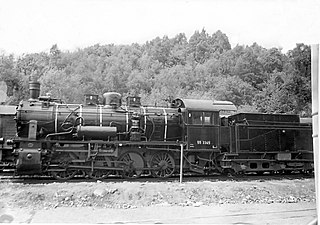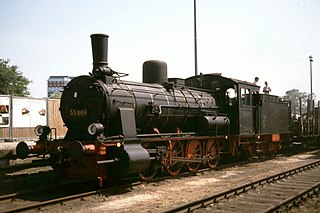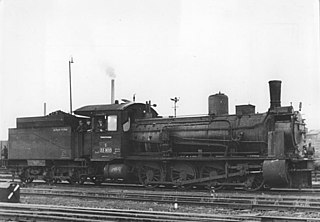
The goods train locomotives of Class C VI were German steam engines built between 1899 and 1905 for the Royal Bavarian State Railways. It had great similarity to the Prussian G 5.4, but had a higher boiler overpressure and better riding qualities. In all the Bavarian state railways procured 83 engines of this type over that period. More machines with slight modifications were acquired between 1907 and 1909. These 37 engines were given the designation G 3/4 N. The Deutsche Reichsbahn inherited 64 Class C VI and 32 Class G 3/4 N engines. These were given operating numbers 54 1301–1364 and 54 1401–1432. The Class C VII locomotives remained in service until 1931, their Class G 3/4 N sister locomotives until 1935.

The Prussian G 8.1 was a heavier, stronger development of the G 8 and was initially referred to as a 'strengthened standard class'.

The Prussian G 10 was a German goods train, steam locomotive, whose design was based on a combination of the running and valve gear from the Prussian T 16 and the boiler from the Prussian P 8. In developing the G 10, however, the T 16 running gear with side play on the first and fifth axles was modified. The T 16 was also subsequently built with this modified configuration and called the Prussian T 16.1. The G 10 was intended for heavy goods train duties on main lines, but as a result of its low axle load it could be employed more flexibly than its equally powerful cousin, the Prussian G 8.1. The G 10 was occasionally even used in passenger train service.

The Oldenburg G 7 steam locomotive was a German 0-8-0 locomotive produced for the Grand Duchy of Oldenburg State Railways. It was an eight-coupled engine, intended for heavy goods train duties, and was based on the Prussian G 7. It had a 1,660 mm diameter boiler located 2,820 mm above the top of the rails in the plate frame, and was equipped with a single Walschaerts valve gear as well as a Lentz valve gear. Thirteen were taken over by the Deutsche Reichsbahn, grouped into DRG Class 55.62 and given numbers 55 6201–55 6213.
The Prussian G 12.1 was a German steam locomotive built for the Prussian state railways during the First World War and was the largest Prussian freight locomotive with a 2-10-0 wheel arrangement. It had three cylinders, the two outer ones driving the third axle and the inner one the second axle.

The Prussian T 16.1 locomotives were built for the Prussian state railways as goods train tank locomotives about the time of the First World War. Six examples were also procured by the Imperial Railways in Alsace-Lorraine.
The Prussian G 5.4 was a German goods train locomotive with a compound engine. Due to its top speed of 65 km/h it was also used on passenger services. The G 5.4, like the G 5.3, differed from the G 5.1 and G 5.2 in having a shorter wheelbase and higher boiler pitch. In addition, the Krauss-Helmholtz bogies enabled its riding qualities to be improved, especially at higher speeds. Between 1901 and 1910 a total of about 760 vehicles of the Class G 5.4 were built for the Prussian state railways. The last 25 locomotives were fitted once again with an Adams axle.

In 1905 the Prussian state railways grouped six-coupled, medium-powered, goods train, tank locomotives into its Class G 3. In addition to standard locomotives, there were also 285 G 3s that were not built to German state railway norms, because they had been built, in most cases, before the foundation of the Prussian state railways.
The Prussian Class G 4 were German, six-coupled, goods train, steam locomotives with a boiler pressure of 12 bar, built primarily for the Prussian state railways. Classified by the state railway in 1905, they included 16 locomotives from the railway division of Mainz, that originally came from the Hessian Ludwigsbahn. These earlier locomotives were delivered between 1872 and 1896 and did not meet the Prussian norms.

The Prussian Class P 6s were passenger locomotives operated by the Prussian state railways with a leading axle and three coupled axles.

The Prussian Class G 7.1 engines of the Prussian state railways were German eight-coupled, goods train, steam locomotives.

The Prussian T 14s were German, 2-8-2T, goods train, tank locomotives operated by the Prussian state railways and the Imperial Railways in Alsace-Lorraine. They were later incorporated by the Deutsche Reichsbahn into their renumbering plan as Class 93.0–4.
The Prussian Class G 5.1 steam engines were the first 2-6-0 goods locomotives in Europe. They were developed for the Prussian state railways from the Class G 4 and a total of no less than 264 units of this class were placed in service in Prussia between 1892 and 1902. The twin-cylinder G 5.1 had been designed to raise the speed of goods trains on main lines. In addition, more powerful engines were needed for the increasingly heavy train loads. The locomotives, which were equipped with a compressed air brake, were used in charge of fast goods trains (Eilgüterzugdienst) and also passenger trains due to their impressive top speed of 65 km/h. The G 5.1 was fitted with inside Allan valve gear and the carrying wheels were of the Adams axle design. The engines were coupled with tenders of Class pr 3 T 12. In Prussian service they were renumbered in 1905 into the 4001–4150 range.

The Prussian Class T 12 is an early, German, passenger train, tank locomotive built for the Prussian state railways in large numbers. These locomotives were superheated variants of the T 11.
The Prussian G 9 was the last saturated locomotive class developed for the Prussian state railways. A total of 200 were put into service between 1908 and 1911, first by Schichau, and later by other locomotive manufacturers. Since problems arose with the G 8, the superheated steam technology was not really trusted. The chassis was taken from the G 7, whereas the larger boiler was a new design. The G 9 remained inferior to the G 8 in terms of performance. At first a number of locomotives were referred to as G 7, but they were later reclassified G 9. They mainly operated in ore traffic between the Ruhr area and the North Sea.

The Prussian G 7.3 was a class of 2-8-0 locomotives of the Prussian state railways. The third class of the G 7 series, they were intended to power heavy goods trains on steep inclines, on which the permissible axle load was not yet that high. This affected for example, the Paderborn–Holzminden and Betzdorf–Siegen routes.

The Prussian G 7.2 was a class of 0-8-0 tender compound locomotives of the Prussian state railways. In the 1925 Deutschen Reichsbahn renumbering plan, the former Prussian locomotives produced from 1895 to 1911 were given the class designation 55.7–13; while the former Grand Duchy of Mecklenburg Friedrich-Franz Railway locomotives were classified as 55.57.
The Prussian G 5.3 was a class of 2-6-0 goods locomotives. They were the two-cylinder-simple version of the compound G 5.4. As with many Prussian locomotive design, simple and compound versions of the same type built. The G 5.3, like the G 5.4, differed from the G 5.1 and G 5.2 as it had a shorter wheelbase and a higher-pitched boiler. The Krauss-Helmholtz bogie was intended to improve the driving characteristics, especially at higher speeds. Production of the G 5.3 was from 1903 until 1906, and 206 units were built.
The Prussian G 5.2 was a class of two-cylinder compound goods locomotive introduced in 1895. As with many Prussian locomotive design, simple and compound versions of the same type were built – in this case the G 5.2 was the two-cylinder compound version of the simple G 5.1. The compound locomotives were more economical and more powerful than the simple locomotives; they were more suitable for long streches with few stops. The newly introduced air brakes made it possible to use the G 5.2 on passenger trains, which the Prussian State Railways often did.
The Prussian G 4.3 was a class of 0-6-0 goods locomotive of the Prussian State Railways; they were manufactured between 1903 and 1907 by Union Giesserei in Königsberg. The type was developed with the aim of improving the running characteristics of 6-coupled locomotives. They proved a more capable design than the normal-type, and so had a higher maximum speed of 60 km/h (37 mph). However, they were quickly outclassed by increasing weight of freight trains.










